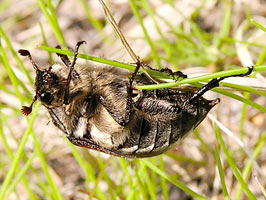Insects
(Insecta)
Insects are the most numerous group of animals on our planet. Their diversity is so large that it exceeds the diversity of all other species of animals and plants combined. The exact number of insect species living on the planet cannot be told. By now, scientists have described about one million of them and every year discover thousands of new ones!
Insects are invertebrate animals; they lack spinal column. But the bodies of adult insects are covered with cuticle a hard outer covering made mostly of chitin and forming an exoskeleton, to which the muscles and other internal organs are attached. Cuticle, however, does not form a hard continuous shell it consists of joined segments; this ensures higher mobility of the body. And it is not only the body that consists of segments, but also the antennae and legs.
* * *
In the development of insect specimens there are sharp changes of stages; they results in deep transformations of the organism so-called metamorphosis. At that, the insect changes drastically its living conditions and way of life. For example, from living in water it begins to live on land and gets wings.
The stages of metamorphosis are the following: egg larva pupa fully grown adult.
Metamorphosis of different kinds of insects may be complete or incomplete.
The latter type of metamorphosis lacks the stage of pupa. The young, called nymph, goes through a series of stages; between them it molts. Having cast off the old skin, a nymph can grow a bit until the new skin becomes hard. Such development is typical for ticks, cockroaches, earwigs, locusts, crickets, true bugs, and some other insects.
In the case of complete metamorphosis, adult form emerges from pupa. Though a pupa does not feed and is immobile (or almost immobile), inside it an intensive transformation goes on. As a result of this transformation, the insect turns from a larva into a fully-formed adult. Especially complex transformations happen with larvae of such insects as flies, in which case in the first days after pupation, the majority of internal organs inside the pupa look like a soupy mixture.
Pupation usually takes place in protected areas (in soil, in forest litter, under bark, in wood), less often in open places (on bark of trees, on leaves, etc). Before pupation, larvae of certain species make cocoons of silk fiber, which they produce; for example, so produced are cocoons of many eggars and silkworms.
* * *
The body of an adult insect is made up of three parts: a head, thorax, and abdomen. On the head, there are main organs of sense and mouthparts. Wings and legs are located on the thoracic part of the body. In the abdomen, the most of the internal organs are located.
* * *
Many people by insects call also such animals as spiders, centipedes, ticks, scorpions. Yet, this is not correct. Though they are close relatives of the insects and classified in one phylum with them (Arthropoda), they represent different classes. Ticks, spiders, and scorpions are included in the class of Arachnida (subphylum Chelicerata). Centipedes are included in another subphylum Myriapoda.
Another name of the insect class Hexapoda (six-legged) explains why the listed above animals cannot be included in this class: insects have six legs, ticks and spiders 8 legs, scorpions and centipedes even more.
* * *
There are two main subclasses of insects:
1. Apterygota primitive and wingless.
2. Pterygota more advanced and winged.
The first subclass comprises insects of the most primitive constitution. Usually they are unseen by people; most of them feed on decaying remains of other organisms. They are widely found in soil, forest litter, moss, decaying wood, and take part in soil formation. Mostly, they are of tiny size (though there are some of 50mm). Non-specialists know few about them.
More often we encounter in our life the representatives of the second subclass more advanced winged insects. It is from this group of insects that we form our ideas about them.
Most representatives of this group, in the adult stage, have wings (independent of whether this wings are used for flying or not). Some species of this subclass lost their wings because they adapted themselves to a specific way of life; nevertheless, by some other features (peculiarities of the structure of respiratory system, mouthparts, etc) they are close to winged insects. For example, bedbug (Cimex lectularius) has no wings, but in their order (Hemiptera) there are many species with developed wings.
This section of the site was created with use of the material from sites www.floranimal.ru and www.zooclub.ru and encyclopedic articles.
To enlarge any photo on the screen click on it with mouse.
Authors of photographs: Olga Stepanets, Ekateria Smirnova, Anton Teplyy, Alexey Shotov, Alla Rohlman.
